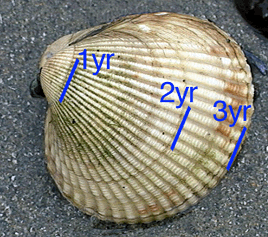Opening seashells to reveal climate secrets Understand article
Seashells are more than just pretty objects: they also help scientists reconstruct past climates.
Seashells – the protective armour of marine molluscs – have a lot in common with trees. When molluscs grow, their shells grow with them, developing a pattern that is similar to tree rings. In shells, these rings are called increments and they record information about the environment in which the organism grew. Moreover, like trees, molluscs can live for a long time, so they can contain climate records that span many years.
The ocean quahog (Arctica islandica), for example, can live up to 500 years. Bivalves in general have inhabited the oceans for more than 500 million years and have fossilised in sedimentary rocks.

shell with a magnifying
glass.
Image courtesy of Bernd
Schöne
Bernd Schöne, a palaeontologist at the University of Mainz, Germany specialises in mollusc sclerochronology (or ‘shell-ring research’), a rather young discipline that uses methods similar to those used in tree-ring research. Bernd, who has been studying shells for 15 years, calls them “a unique climate archive”. “The way that shells grow varies depending on environmental conditions like temperature, food availability and water conditions,” he explains. “So studying them can give us clues on what these conditions were in the past.”
Reconstructing environmental change
Like teeth and bones, shells are composite materials made of calcium carbonate (CaCO3) and large organic molecules (polymers) such as proteins. Calcium carbonate is the inorganic substance that accumulates in our washing machines and kettles in the form of limescale. In shells, it is present as calcite or aragonite and forms crystals that molluscs mould and ‘glue together’ with the organic polymers. As they grow, bivalve molluscs add layers of this mixture of calcium carbonate and polymers to their shells.
However, this shell growth isn’t continuous. “When molluscs encounter a limited supply of food or changed temperatures or water quality, shell growth slows down and a line forms,” explains Bernd. “When conditions improve, the shell grows again.” The result is a regular pattern of growth lines (due to slow growth) and increments (due to rapid growth), which can be used like a calendar to reconstruct and date environmental change. If the exact date when the mollusc died is known, for example, scientists can count backwards to date the other lines.

carbonate.
Image courtesy of Nicola Graf
Another way to deduce environmental change from shells is to analyse their chemical composition. Oxygen has three forms (isotopes): oxygen-16, oxygen-17 and oxygen-18, which are determined by the number of neutrons in the nucleus. In cold water, the proportion of oxygen-18 to oxygen-16 is higher than it is in warm water and the oxygen-18 is more easily incorporated into shells than oxygen-16. By analysing the ratios between oxygen isotopes in a shell, therefore, scientists can tell what water temperatures were like at the time when the shell grew.
But how can scientists tell when that was? They do so by counting the number of increments and lines, just as the age of a tree can be measured by counting its rings. However, shells have an advantage over trees: they form daily rings instead of the annual rings of trees. This can give a much more detailed picture of the environmental conditions that influenced their growth. Because different specimens of the same species record environmental conditions in the same way, their individual records can be combined into a master chronology of climatic events. This calendar not only can help to make other environmental records more accurate but also can be extended back in time to before humans started recording the climate.
Using shells as records, Bernd and his team have managed to reconstruct the climate in the North Atlantic region over the past 500 years. More precisely, they determined that the North Sea warmed up by one degree Celsius in the past 150 years. More broadly, Bernd used specimens of Arctica islandicato measure how levels of carbon dioxide and temperatures in the world’s oceans changed thousands of years ago, finding clear evidence of extreme weather events, such as the Little Ice Age (1300-1850), and variations in recurring weather phenomena such as El Niño.
What does the future hold for molluscs?

Clinocardium nuttallii, with
the most obvious growth
lines indicated, suggesting
an age of three years.
Image courtesy of
www.asnailsodyssey.com
Molluscs can help us to reconstruct past climates, but what about predicting the evolution of climate change? Climate predictions, Bernd points out, are the domain of climatologists, but the study of past shell growth may help to predict how current and future climate change could affect shell-growing animals. Because shell growth depends on very specific environmental conditions, Bernd warns that climate change “could have a negative effect on the animals’ ability to build their shells”.
For example, Bernd and his colleagues have found a correlation between shell growth and water temperature. “Each species is adapted to its own, specific temperature range: the animals’ metabolism works best within that range,” he explains. “If temperatures are above or below that range, their shells stop growing.”
Ocean acidification – the decrease in oceanic pH value caused by dissolved carbon dioxide from the atmosphere is another variable that could affect molluscs. “The pH value is currently 7.9 to 8.0,” explains Bernd. “Over the next century, it could drop by 0.1 to 0.3 units.” If this trend continued for several centuries, the water would become more and more acidic, and some species could have difficulties forming shells at all. “This doesn’t necessarily mean that these animals will die out,” says Bernd. “It is too early to tell because studies on the effects of the changed pH value on molluscs are still rare and somewhat contradictory.” But climate change might favour some species over others.
Even though molluscs are very sensitive to changes in their environment, they have adapted to all of Earth’s main environments (marine, freshwater, terrestrial) and are currently the second largest group of invertebrates. Some even live in unusually acidic environments, such as oceanic volcanic areas, and might hold clues on how to mitigate the effect of oceanic acidification in the future.
Resources
- Check the Tara expedition website for activities to do in the classroom to explain the various physico-chemical properties of the ocean.
- The international agreement on climate reached during the COP21 (December 2015) may have an impact on the current ocean acidification.
Review
This article helps students to realize that molluscs, like every living being, are open systems that interact constantly with the surrounding environment. It explains how the shells of molluscs are formed and how this can be used in climate research (in order to understand the causes and consequences of it). Secondary teachers can also use this article as a primer for discussion about the interactions between the subsystems of earth (biosphere, geosphere, hydrosphere and atmosphere). Potential other topics for discussion include:
- How does this research area exemplifies the interaction between Biosphere – Geosphere – Hydrosphere – Atmosphere?
- Considering the present climate change. Predict the ratio of oxygen 16/18 in the ocean water. Explain your reasoning.
- “It seems that molluscs are here to stay, despite the climate changes”. Discuss this sentence according to the evolutionist perspective of Charles Darwin.
Betina Lopes, Portugal





